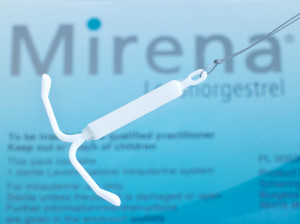What is an IUD?
IUD or Intrauterine Device is a little plastic devices which are inserted inside the uterus.
Nowadays, the two main types available in Australia are Copper IUDs (Multiload®) and Levonorgestrel IUD (Mirena®)

How does the IUD work?
The IUD affects sperm movement and survival in the uterus (womb) so that they cannot reach the egg to fertilise it. The IUD also changes the lining of the womb (endometrium) so that it is not suitable for pregnancy and prevents an egg – if it does become fertilised – from developing.
How well does it work?
No contraception is 100% effective but IUD is > 99 % effective.
What are the advantages of IUD?
• Effective long term contraception
• Easy to maintain (you can’t forget to use it as you might with the pill)
• Cheaper in long term
• You can try for pregnancy as soon as it is removed.
The progesterone IUD (Mirena) has the added benefit of reducing menstrual bleeding as it contains progesterone which thins the lining of the uterus in addition to its use as a contraceptive device.

What are the disadvantages of IUD?
• May expel itself from uterus, usually during a period.
• although rare, when an IUD fails and a woman becomes pregnant, it must be removed ASAP. An IUD in a pregnant woman increases risk of miscarriage
• Small risk of infection in the first few weeks following insertion
• It is important you be particularly careful about protecting yourself from sexually transmitted infections
• IUD may perforate the wall of the uterus during insertion (very rare)
• Risk of an ectopic pregnancy (pregnancy in the fallopian tubes) when the IUD fails.
The progesterone IUD can also have the following side effects:
• Irregular bleeding or periods are likely in the first 3-6 months.
• May cause a slight increase in vaginal dryness, flushing, headaches, nausea and acne.
The copper IUD may cause your periods to become heavier and more painful.
Who can use an IUD?
• Women at low risk of contracting sexually transmitted infections.
• Women who cannot or do not wish to take the Pill.
Who should not use an IUD?
• Women who are at risk of contracting sexually transmitted infections
• Women who have undiagnosed vaginal bleeding.
• Women with pelvic inflammatory disease (PID).
How the IUD is fitted
Before you have an IUD fitted you should:
• Have a cervical screening test and swabs to rule out any pelvic infections
• Ensure that you are not pregnant
You will be placed in the same position in the clinic as if you were about to have a Cervical screening test. A speculum will be placed in your vagina and your cervix cleaned with an antiseptic. The length of the uterus is measured and the IUD is placed inside through the cervix. The string is cut so that it is well up into the vagina. You or your sexual partner won’t notice it but you should be able to feel the string if you reach right up into your vagina.
It is important that you do not have intercourse or use tampons for 48 hours following insertion to prevent infection.

What if I feel that something is wrong?
• The string feels like it is shorter or longer than normal or you cannot feel the string at all. This means that the IUD may have shifted.
• Persistent lower abdominal cramping pain, especially associated with a fever
• Unusual discharge or bleeding
